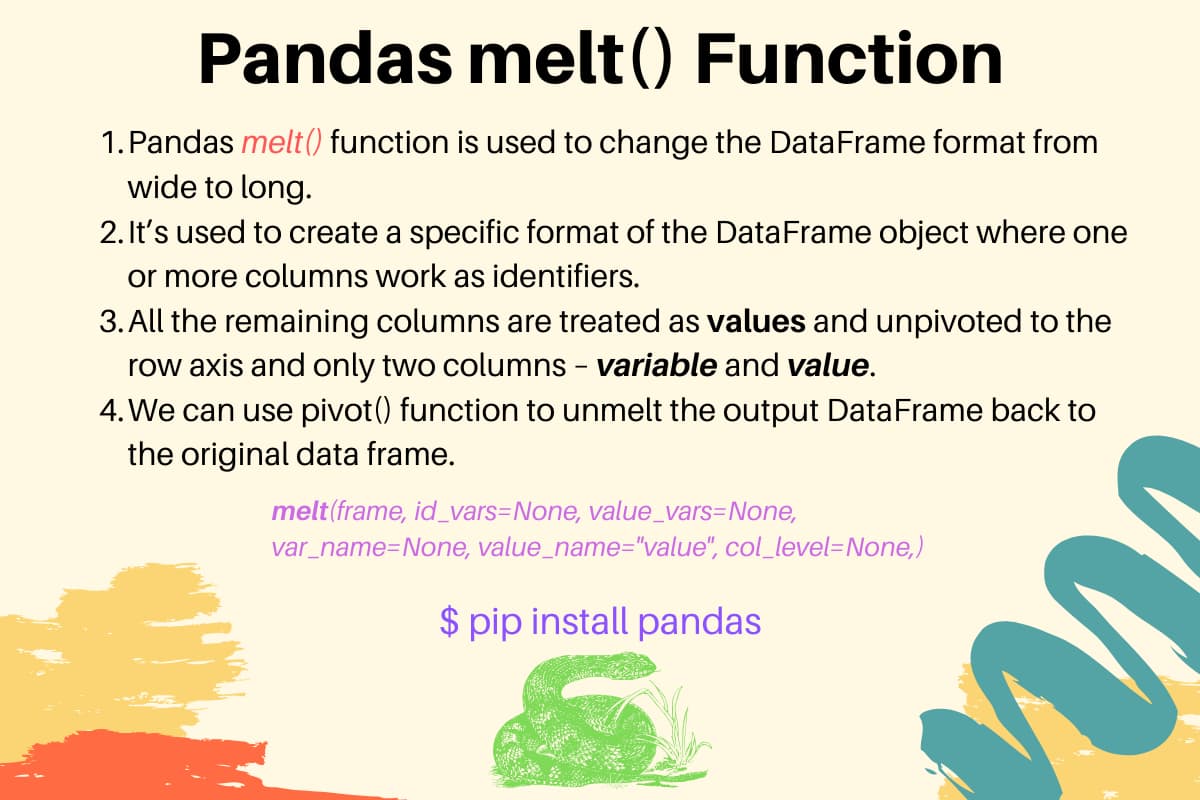- Log in to:
- Community
- DigitalOcean
- Sign up for:
- Community
- DigitalOcean
By Pankaj Kumar

Pandas melt() function is used to change the DataFrame format from wide to long. It’s used to create a specific format of the DataFrame object where one or more columns work as identifiers. All the remaining columns are treated as values and unpivoted to the row axis and only two columns - variable and value.
1. Pandas melt() Example
The use of melt() function is more clear when looked through an example.
import pandas as pd
d1 = {"Name": ["Pankaj", "Lisa", "David"], "ID": [1, 2, 3], "Role": ["CEO", "Editor", "Author"]}
df = pd.DataFrame(d1)
print(df)
df_melted = pd.melt(df, id_vars=["ID"], value_vars=["Name", "Role"])
print(df_melted)
Output:
Name ID Role
0 Pankaj 1 CEO
1 Lisa 2 Editor
2 David 3 Author
ID variable value
0 1 Name Pankaj
1 2 Name Lisa
2 3 Name David
3 1 Role CEO
4 2 Role Editor
5 3 Role Author
We can pass the ‘var_name’ and ‘value_name’ parameters to change the column names of ‘variable’ and ‘value’.
df_melted = pd.melt(df, id_vars=["ID"], value_vars=["Name", "Role"], var_name="Attribute", value_name="Value")
Recommended Read: Python Pandas Tutorial
2. Multiple Columns as id_vars
Let’s see what happens when we pass multiple columns as the id_vars parameter.
df_melted = pd.melt(df, id_vars=["ID", "Name"], value_vars=["Role"])
print(df_melted)
Output:
ID Name variable value
0 1 Pankaj Role CEO
1 2 Lisa Role Editor
2 3 David Role Author
3. Skipping Columns in melt() Function
It’s not required to use all the rows from the source DataFrame. Let’s skip the “ID” column in the next example.
df_melted = pd.melt(df, id_vars=["Name"], value_vars=["Role"])
print(df_melted)
Output:
Name variable value
0 Pankaj Role CEO
1 Lisa Role Editor
2 David Role Author
4. Unmelting DataFrame using pivot() function
We can use pivot() function to unmelt a DataFrame object and get the original dataframe. The pivot() function ‘index’ parameter value should be same as the ‘id_vars’ value. The ‘columns’ value should be passed as the name of the ‘variable’ column.
import pandas as pd
d1 = {"Name": ["Pankaj", "Lisa", "David"], "ID": [1, 2, 3], "Role": ["CEO", "Editor", "Author"]}
df = pd.DataFrame(d1)
# print(df)
df_melted = pd.melt(df, id_vars=["ID"], value_vars=["Name", "Role"], var_name="Attribute", value_name="Value")
print(df_melted)
# unmelting using pivot()
df_unmelted = df_melted.pivot(index='ID', columns='Attribute')
print(df_unmelted)
Output:
ID Attribute Value
0 1 Name Pankaj
1 2 Name Lisa
2 3 Name David
3 1 Role CEO
4 2 Role Editor
5 3 Role Author
Value
Attribute Name Role
ID
1 Pankaj CEO
2 Lisa Editor
3 David Author
The unmelted DataFrame values are the same as the original DataFrame. But, the columns and index need some minor changes to make it exactly like the original data frame.
df_unmelted = df_unmelted['Value'].reset_index()
df_unmelted.columns.name = None
print(df_unmelted)
Output:
ID Name Role
0 1 Pankaj CEO
1 2 Lisa Editor
2 3 David Author
Reference: pandas melt() API Doc
Thanks for learning with the DigitalOcean Community. Check out our offerings for compute, storage, networking, and managed databases.
About the author
Java and Python Developer for 20+ years, Open Source Enthusiast, Founder of https://www.askpython.com/, https://www.linuxfordevices.com/, and JournalDev.com (acquired by DigitalOcean). Passionate about writing technical articles and sharing knowledge with others. Love Java, Python, Unix and related technologies. Follow my X @PankajWebDev
Still looking for an answer?
- Table of contents
- 1\. Pandas melt() Example
- 2\. Multiple Columns as id\_vars
- 3\. Skipping Columns in melt() Function
- 4\. Unmelting DataFrame using pivot() function
Deploy on DigitalOcean
Click below to sign up for DigitalOcean's virtual machines, Databases, and AIML products.
Become a contributor for community
Get paid to write technical tutorials and select a tech-focused charity to receive a matching donation.
DigitalOcean Documentation
Full documentation for every DigitalOcean product.
Resources for startups and SMBs
The Wave has everything you need to know about building a business, from raising funding to marketing your product.
Get our newsletter
Stay up to date by signing up for DigitalOcean’s Infrastructure as a Newsletter.
New accounts only. By submitting your email you agree to our Privacy Policy
The developer cloud
Scale up as you grow — whether you're running one virtual machine or ten thousand.
Get started for free
Sign up and get $200 in credit for your first 60 days with DigitalOcean.*
*This promotional offer applies to new accounts only.
